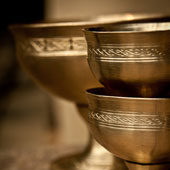Design Resource
Bell Metal Craft of Sarthebari
The Craft of Utensils
by
Process of making bell metal bowls and other items
Bell metal as a craft has survived for ages, yet there seems to be very little transition in the method of preparing bell metal items so far as Sarthebari is concerned.
The craftsmen who are also referred to as the Kahar or Orja still resort to the age old tools required for burning and shaping the metal.
Processing the raw material
The raw material is often imported from Kolkata and even countries like Pakistan and Bangladesh.
The craftsmen still follow the indigenous process of melting the raw material. The raw material is often purchased in the form of old used bell metal items such as bowls, drinking glasses or plates.
After hammering the raw material into small pieces these are put inside an iron vessel and placed in the fire vent also known as Kah Galuwa Apor in the local language. The fire vent is occasionally pumped with machines to ignite the flames.
Solidifying the molten metal
Once the raw metal takes a complete molten form, the iron vessel is taken out and the piping hot liquid metal is poured over the flat round surface of the earthen crucibles which is previously dabbed with mustard oil. The molten metal solidifies forming small round, bell metal ingots.
These metal ingots are then again burnt in a fire vent, so as to soften them and are then hammered continuously to give them the required shape. After the rough shape is formed, the bowl is beaten with a small hammer to give it a final shape.
Filing of the rough edges
Once the bell metal bowls are formed, the rough edges of the bowl are filed off manually using a strong and flat iron filer, called the Reti or Ou.
Scraping off the burnt layer
To scrap off the darkened burnt layer from the bell metal bowl, a long iron rod with sharp edges called the Khonta by the local craftsmen. This is basically done to bring the shine and glaze to the bell metalware.
The process is very tedious and requires a lot of strength and pressure.
Carving imprints on the bell metalware
Once the basic bell metal bowl is made, its base is heated in another fire vent called the Kunda Apor and then sealing wax is used to fix the base of the bowl to a rolling bamboo tool called the Kunda Saal.
The Kunda Saal is made to spin with the use of a pulley tugged at one side and on the other side a sharp edged instrument, twisted at the tip called the Luwaal is used to carve rings into the spinning bowl.
Bhor Mara or carving rings on the bowl
In order to give final touches to the bell metal bowl, a sharp tool made of iron is used. The craftsman uses a small instrument called the Dhonukar as it is shaped like the traditional bow.
One end of the sharp tool is put inside a small metallic cup placed in the palm of the craftsman for applying pressure while the other end is used to carve motifs and patterns on it.


































